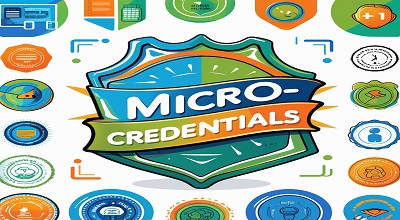Micro-Credential
Micro-credential are gaining momentum in the educational and professional sectors as a modern way to recognize specialized skills and competencies. Unlike traditional degrees, which cover broad fields of study, micro-credentials are focused on specific skills or knowledge areas, offering a flexible and targeted approach to learning. But what exactly are micro-credentials, and why are they becoming so popular? This article delves deep into the concept of micro-credentials, their benefits, applications, and how they can be a game-changer in the learning landscape.
What are Micro-Credentials?
A micro-credential is a certification that validates a specific skill or competency. These credentials are typically earned through short, focused learning experiences that can take the form of online courses, workshops, or training programs. Micro-credentials are designed to be more accessible and flexible than traditional educational programs, allowing learners to upskill or reskill in a relatively short time.
Key Characteristics of Micro-Credentials
- Focused Learning: Micro-credentials target a single skill or knowledge area.
- Short Duration: Programs are usually completed in weeks or months.
- Flexible Delivery: Many micro-credential programs are offered online, providing accessibility and convenience.
- Stackable: Learners can combine multiple micro-credentials to build a portfolio of skills.
- Industry-Aligned: Often developed in collaboration with employers, micro-credentials are tailored to meet workforce demands.
The Rise of Micro-Credentials
The concept of micro-credentials has emerged in response to the rapidly changing job market. Traditional degrees often take years to complete and may not address the specific skills required by employers. Micro-credentials fill this gap by providing just-in-time learning opportunities that are directly applicable to real-world challenges.
Factors Driving the Popularity of Micro-Credentials
- Technological Advancements: The rise of online learning platforms has made micro-credentials more accessible.
- Workforce Demands: Employers value specialized skills that can be demonstrated through micro-credentials.
- Cost-Effectiveness: Micro-credentials are often more affordable than traditional education.
- Lifelong Learning: Professionals are increasingly seeking ways to update their skills throughout their careers.
Benefits of Micro-Credentials
Micro-credentials offer numerous advantages to learners, educators, and employers alike. Below are some key benefits:
1: For Learners
- Career Advancement: Gain skills that are directly relevant to your industry.
- Flexibility: Learn at your own pace and on your own schedule.
- Affordability: Avoid the high costs associated with traditional degrees.
- Portfolio Building: Showcase your skills to potential employers.
2: For Educators
- Engagement: Offer bite-sized, targeted learning experiences to attract diverse learners.
- Customization: Tailor content to meet specific industry or learner needs.
3: For Employers
- Skill Verification: Easily verify the competencies of potential hires.
- Upskilling Workforce: Provide employees with opportunities for continuous learning.
- Adaptability: Address skill gaps in real-time to keep up with market changes.
Types of Micro-Credentials
Micro-credentials can take many forms depending on the skills or knowledge they certify. Some common types include:
1. Digital Skills
Certifications in areas like coding, data analysis, and digital marketing.
2. Soft Skills
Focus on communication, teamwork, leadership, and other interpersonal skills.
3. Industry-Specific Skills
Specialized training for fields such as healthcare, finance, or education.
4. Emerging Technologies
Courses on blockchain, artificial intelligence, and other cutting-edge technologies.
How to Earn a Micro-Credential?
Earning a micro-credential typically involves:
- Enrolling in a Program: Choose a reputable provider that aligns with your goals.
- Completing the Requirements: Engage with the course material, assignments, or projects.
- Passing Assessments: Demonstrate your competency through exams, projects, or practical applications.
- Receiving Certification: Earn a digital badge or certificate upon successful completion.
Micro-Credentials vs. Traditional Education
While micro-credentials and traditional education serve different purposes, they are not mutually exclusive. Below is a comparison:
| Aspect | Micro-Credentials | Traditional Education |
|---|---|---|
| Duration | Weeks to months | Years |
| Focus | Specific skills | Broad knowledge |
| Flexibility | High | Low |
| Cost | Affordable | Expensive |
| Recognition | Growing | Widely established |
Challenges of Micro-Credentials
Despite their advantages, micro-credentials face some challenges:
1. Recognition
Not all employers or institutions recognize micro-credentials yet.
2. Quality Assurance
The lack of standardization can lead to varying quality among providers.
3. Overload
The abundance of micro-credential options can be overwhelming for learners.
4. Integration
Integrating micro-credentials into traditional education systems remains a challenge.
The Future of Micro-Credentials
The future of micro-credentials looks promising, with potential developments including:
- Increased Adoption: More employers and institutions recognizing their value.
- Standardization: Efforts to ensure consistent quality across providers.
- Global Reach: Expansion of online platforms to make micro-credentials accessible worldwide.
- Integration with Technology: Use of blockchain for secure and verifiable digital badges.
FAQs About Micro-Credentials
1. What is the purpose of a micro-credential?
The purpose of a micro-credential is to certify specific skills or competencies, making it easier for learners to demonstrate their expertise in a targeted area.
2. How are micro-credentials different from traditional degrees?
Micro-credentials focus on specific skills and are typically shorter and more flexible than traditional degrees, which cover broader subject areas.
3. Are micro-credentials recognized by employers?
While recognition is growing, it varies by industry and employer. Choosing a reputable provider can enhance recognition.
4. How long does it take to earn a micro-credential?
Most micro-credential programs can be completed within weeks or months.
5. Can micro-credentials be stacked?
Yes, many micro-credentials are stackable, allowing learners to build a comprehensive portfolio of skills.
6. How much do micro-credentials cost?
Costs vary widely but are generally more affordable than traditional degree programs.
7. Where can I find micro-credential programs?
Micro-credential programs are offered by universities, online learning platforms, and professional organizations.
Summary
Micro-credentials represent a significant shift in the way we approach education and professional development. By offering targeted, flexible, and affordable learning opportunities, they empower individuals to stay competitive in a rapidly evolving job market. Whether you are looking to upskill, reskill, or explore a new field, micro-credentials can be a valuable addition to your educational journey.
